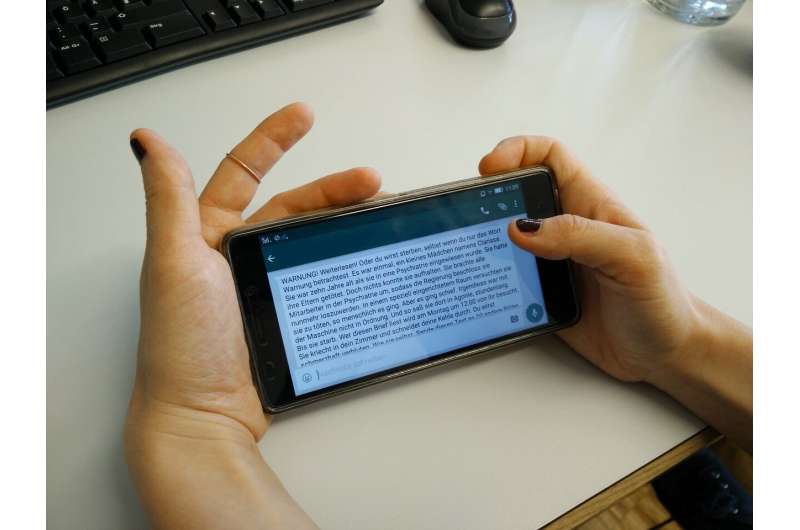Social media addiction linked to cyberbullying

As social media platforms like Instagram, Snapchat, TikTok and others continue to grow in popularity, adolescents are spending more of their time online navigating a complex virtual world.
New research suggests that these increased hours spent online may be associated with cyberbullying behaviors. According to a study by the University of Georgia, higher social media addiction scores, more hours spent online, and identifying as male significantly predicted cyberbullying perpetration in adolescents.
“There are some people who engage in cyberbullying online because of the anonymity and the fact that there’s no retaliation,” said Amanda Giordano, principal investigator of the study and associate professor in the UGA Mary Frances Early College of Education. “You have these adolescents who are still in the midst of cognitive development, but we’re giving them technology that has a worldwide audience and then expecting them to make good choices.”
Cyberbullying can take on many forms, including personal attacks, harassment or discriminatory behavior, spreading defamatory information, misrepresenting oneself online, spreading private information, social exclusion and cyberstalking.
The study surveyed adolescents ranging in age from 13-19 years old. Of the 428 people surveyed, 214 (50%) identified as female, 210 (49.1%) as male, and four (0.9%) as other.
Exploring social media addiction
When adolescents are online, they adapt to a different set of social norms than when they’re interacting with their peers in person. Oftentimes, they are more aggressive or critical on social media because of the anonymity they have online and their ability to avoid retaliation. Additionally, cyberbullies may feel less remorse or empathy when engaging in these behaviors because they can’t see the direct impact of their actions.
“The perpetrator doesn’t get a chance to see how damaging their bullying is and to learn from their mistakes and do something different,” said Giordano. “It’s a scary situation because they don’t have the natural consequences they do with offline bullying.”
Teenagers who are addicted to social media are more likely to engage in cyberbullying, as well as those who spend more time online. Participants in the study reported spending on average over seven hours online per day, and the reported average maximum hours spent online in one day was over 12 hours.
“Social media addiction is when people crave it when they’re not on it, and continue their social media use despite negative consequences,” said Giordano. “Some negative consequences could be they’re tired during the day because they’re scrolling all night long, they’re having conflicts with their parents, they’re getting poor grades in school or they’re engaging in actions online that they later regret, but they still continue to use social media.”
Social networking sites are designed to give people a dopamine hit, she added, and some people compulsively look for that hit. “It’s feeding into that addictive behavior, and they may be using cyberbullying as a way to get likes, shares, comments and retweets,” she said. “That’s the common thread you see in behavioral addictions—people start relying on a rewarding behavior as a way to make them feel better when they’re experiencing negative emotions. And so, I think the social media addiction piece is really interesting to show that there’s another factor at play here in addition to the number of hours spent online.”
The study also found that adolescent males are more likely to engage in cyberbullying than females, aligning with past studies that show aggressive behaviors tend to be more male driven. More research on the socialization process of men can help determine what’s leading them to engage in more cyberbullying behaviors.
Next steps for counselors and clinicians
Giordano believes that counselors need to start assessing adolescents for social media addiction if they are engaging in cyberbullying and to provide treatment plans to help redefine their relationship with technology. These interventions may include helping adolescents examine how they define their self-worth and restricting the amount of time they spend on social media platforms.
“There’s quite a few strong and reliable assessments for social media addiction for adolescents that have good psychometric properties,” said Giordano. “I think when clinicians see cyberbullying happen, they really need to explore the individual’s relationship with social media and to address social media addiction, not just the cyberbullying.”
Often, school counselors are not aware of cyberbullying until after an incident occurs. To address this issue, Giordano recommends that schools start educating students earlier about cyberbullying and social media addiction as a preventive method instead of waiting to repair the damage. Whether it’s through an awareness campaign or support group, schools can help students talk about cyberbullying to give them a chance to understand the consequences of their actions and prepare them for potential risks.
“We need schools and school counselors to do this preventative work early and educate students about the risk of addiction with some of these rewarding behaviors like gaming and social media,” said Giordano. “We need to teach them the warning signs of behavioral addiction, what to do if they start to feel like they’re losing control over their behaviors and help them find other ways to manage their emotions, rather than turning to these behaviors. There are a lot of programs already moving in this direction, and I think that’s amazing and there needs to be more of it.”
Counselors can help decrease the risk of some of these addictive behaviors at a young age by teaching and equipping children with emotional regulation skills and other ways to cope with their feelings.
Source: Read Full Article
